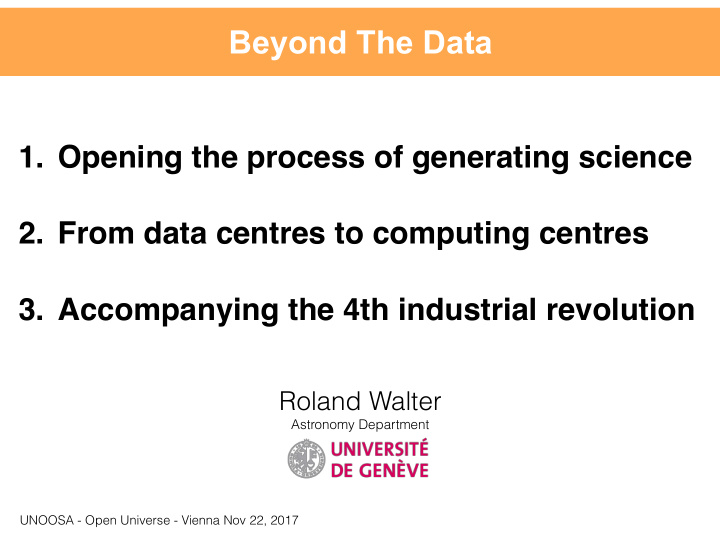



Beyond The Data 1. Opening the process of generating science 2. From data centres to computing centres 3. Accompanying the 4th industrial revolution Roland Walter Astronomy Department UNOOSA - Open Universe - Vienna Nov 22, 2017
Opening the Process of Generating Science Computing centres Federation of data centres Interpretation Services Requests Data Data centres Requests Requests Analysis Infrastructure Data services & Access Data Data Analysis SW The FCC revealed its plan to repeal net neutrality. It could change how we use the Internet.
HEAVENS http://www.isdc.unige.ch/heavens/ This was in 2005 One can go much further ! This is not just an other interface, it has added value through unique Driven by the needs of science, analysis pipelines education and outreach UNOOSA - Open Universe - Roma April 12, 2017
From Data Centres to Computing Centres 10000 I I e s a h p C H L 1000 LHC INTEGRAL A 0.001 PB/y K particle physics S 2001- 100 CTA CTA 12 PB/y Moore’s law 2019- 10 Peta Bytes LSST 15 PB/y 2022- 1 LEP SKA 300 PB/y 2025?- 0,1 y LEP m 0.04 PB/y o n 1989-2000 o r t 0,01 s LHC a 30 PB/y 2010- 0,001 0,0001 1995 2000 2005 2010 2015 2020 2025 2030 2035 Centralised (“cloud”) computing centres Distributed data centres Distributed data centres are not cost effective. In the next years services are likely to be integrated in large computing centres supporting experiments generating Big Data.
From Data Centres to Computing Centres Large computing centres exist today Cray XC 50 at the Swiss National Supercomputing Centre (Lugano) 361760 cores equivalent 6500 Tesla GPU 6 PB scratch disks 200 PB tape storage 100 Gbps internet connection Only European machine in Top10 #3 in Top500 #6 in TopGreen >100x typical University computing
Evolution of Data Knowledge Management ➙ People want results and data ➙ Generating results shall not require specific knowledge ➙ Results shall be tailored to the user's (scientists, school, public) needs ➙ Results shall be related to the physics, not to observations/ instruments Services need to add scientific value to the data
Evolution of Knowledge Management Common sense Computing Volume Knowledge 2025 Synthetic Interpretation 2005 Analysis Analytic 1985 Data & Information
Opening the Process of Generating Science Common sense data mining is a dynamic system driven by science Knowledge and education 2025 Synthetic Interpretation 2005 Analysis Analytic requires integration 1985 of archive, pipeline & interpretation Data & Information
Opening the Process of Generating Science Common sense Driven by Artificial Intelligence & Computing Knowledge 2025 Power Synthetic Interpretation The 4th Industrial Revolution 2005 Analysis Analytic 1985 Data & Information
The 4th Industrial Revolution ➙ AI speaks to us via our smartphones ➙ AI searches and finds for us ➙ AI recognises us ➙ AI monitors our health and helps decide on medical treatments ➙ AI assists lawyers and the military ➙ AI will soon drive our cars and work at our place ➙ AI transforms science and education and comes at the rescue interpreting data flows exceeding human insight Klaus Schwab, World Economic Forum executive chairman: One ambition of the VO Previous industrial revolutions liberated humankind from animal power, made mass production possible and brought digital capabilities to billions of people. This Fourth Industrial Revolution is, however, fundamentally different. It is characterised by a range of new technologies that are fusing the physical, digital and biological worlds, impacting all disciplines, economies and industries, and even challenging ideas about what it means to be human. The business models or each and every industry will be transformed. Should this not be the ambition of the OpenUniverse ??
The 4th Industrial Revolution Deep Learning does not need human knowledge to discover… • Features extraction based on training data alone, no user interaction • Computationally expensive • Best architecture not intuitive Images taken from hackernoon.com and deeplearning.net
Classification via Deep Learning Cherenkov Telescope Array proton photon • Use state-of-the-art InceptionV3 from Google The place to be True Positive Rate • Apply to Cherenkov event Lyard & RW, UniGE, 2017 for classification False Positive Rate
Characterising Galaxies via Deep Learning Square Kilometer Array Euclid Detection of gravitational lenses • Kneib et al, EPFL, 2017 Image denoising • Aniyan et al, SKA Cape Town, 2017 Schawinski et al, ETHZ, 2017
Feeding Old Data to AI ? ➙ Instrument Idiosyncrasie detection and deconvolution ➙ Global search ➙ Searching features in the noise ➙ Denoising data ➙ Finding mistakes ! ➙ …. (we are only at the very beginning of AI…)
Legacy, a 30 years tribute This mission brought not only new capabilities that resulted in unexpected discoveries, but also a pioneering approach to operations and archiving that changed X-ray astronomy... Nicholas White EXOSAT 1983-1986 The world is moving in a new direction, should the OpenUniverse targets 30 years old ideas ?
Where is the future ? • Increase transparency Improving the outcomes of the • Resurface data 3rd industrial revolution • Broaden the user base We have mostly discussed • “Digital divide” 30 years old ideas And / Or Accompanying the 4th industrial revolution • Universal access to modern investigations and computing power • Free internet & computing… • Resolving the “Artificial Intelligence divide” • Make data accessible to modern analysis techniques Any interest ? A Great challenge for the UN
Recommend
More recommend